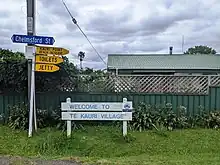Kauri Point | |
|---|---|
Rural settlement | |
 | |
| Coordinates: 37°30′43″S 175°58′30″E / 37.512°S 175.975°E | |
| Country | New Zealand |
| Region | Bay of Plenty |
| Territorial authority | Western Bay of Plenty District |
| Ward | Katikati-Waihi Beach Ward |
| Community | Katikati Community |
| Electorates | |
| Government | |
| • Territorial Authority | Western Bay of Plenty District Council |
| • Regional council | Bay of Plenty Regional Council |
| Area | |
| • Total | 0.27 km2 (0.10 sq mi) |
| Population (2018 Census)[2] | |
| • Total | 177 |
| • Density | 660/km2 (1,700/sq mi) |
| Postcode(s) | 3170 |
Kauri Point is a rural settlement in the Western Bay of Plenty District and Bay of Plenty Region of New Zealand's North Island. It is on a headland on the eastern side of Tauranga Harbour, opposite Matakana Island.[3]
A coastal walkway through Kauri Point Historic Reserve connects Kauri Point to Ongare Point.[4] There are mature pōhutakawa trees and three pā sites in the reserve.[5][6] A 200 metre long wooden jetty, built after 1947, provides fishing access to the harbour.[7][8]
Dorothy Morris was a pioneer of the kiwifruit industry in New Zealand who she converted her dairy farm on Kauri Point Road to kiwifruit in the 1950s.[9]
George Vesey Stewart, who organised settlement of Katikati in the 1870s, initially planned for the town to be established at Kauri Point.[10] The settlement at Kauri Point did not eventuate until the 1970s.[11]
Demographics
Ōngare Point-Kauri Point is defined by Statistics New Zealand as a rural settlement. Kauri Point covers 0.27 km2 (0.10 sq mi).[1] It is part of the wider Tahawai statistical area.[12]
| Year | Pop. | ±% p.a. |
|---|---|---|
| 2006 | 189 | — |
| 2013 | 171 | −1.42% |
| 2018 | 177 | +0.69% |
| Source: [2] | ||

Kauri Point had a population of 177 at the 2018 New Zealand census, an increase of 6 people (3.5%) since the 2013 census, and a decrease of 12 people (−6.3%) since the 2006 census. There were 75 households, comprising 84 males and 90 females, giving a sex ratio of 0.93 males per female. The median age was 54.2 years (compared with 37.4 years nationally), with 33 people (18.6%) aged under 15 years, 15 (8.5%) aged 15 to 29, 78 (44.1%) aged 30 to 64, and 51 (28.8%) aged 65 or older.
Ethnicities were 89.8% European/Pākehā, 13.6% Māori, 3.4% Asian, and 5.1% other ethnicities. People may identify with more than one ethnicity.
Although some people chose not to answer the census's question about religious affiliation, 54.2% had no religion, 27.1% were Christian, and 1.7% had Māori religious beliefs.
Of those at least 15 years old, 21 (14.6%) people had a bachelor's or higher degree, and 36 (25.0%) people had no formal qualifications. The median income was $24,900, compared with $31,800 nationally. 21 people (14.6%) earned over $70,000 compared to 17.2% nationally. The employment status of those at least 15 was that 57 (39.6%) people were employed full-time, 24 (16.7%) were part-time, and 6 (4.2%) were unemployed.[2]
References
- 1 2 "ArcGIS Web Application". statsnz.maps.arcgis.com. Retrieved 26 November 2022.
- 1 2 3 "Statistical area 1 dataset for 2018 Census". Statistics New Zealand. March 2020. 7013536.
- ↑ Harriss, Gavin (August 2022). Kauri Point, Bay of Plenty (Map). NZ Topo Map.
- ↑ "Kauri Point – Ongare Point". motowalknz. 5 March 2016.
- ↑ Golson, J (1961). "Investigations at Kauri Point, Katikati, western Bay of Plenty". New Zealand Archaeological Association.
- ↑ Law, Garry (5 September 2016). "Kauri Point Pa". Archaeopedia New Zealand.
- ↑ "Jetty at Kauri Point". Bay of Plenty Times. 3 December 1947.
- ↑ "Kauri Point Historic Reserve". Western Bay of Plenty District Council. Retrieved 26 November 2022.
- ↑ "Book celebrates kiwifruit pioneer Dorothy Morris". Katikati Advertiser. 16 May 2019.
- ↑ Jordan, E T (September 1983). "Early Katikati – The Present Katikati". Ohinemuri Regional History Journal.
- ↑ McKinnon, Malcolm (1 July 2015). "Katikati". Te Ara: The Encyclopedia of New Zealand.
- ↑ 2018 Census place summary: Tahawai